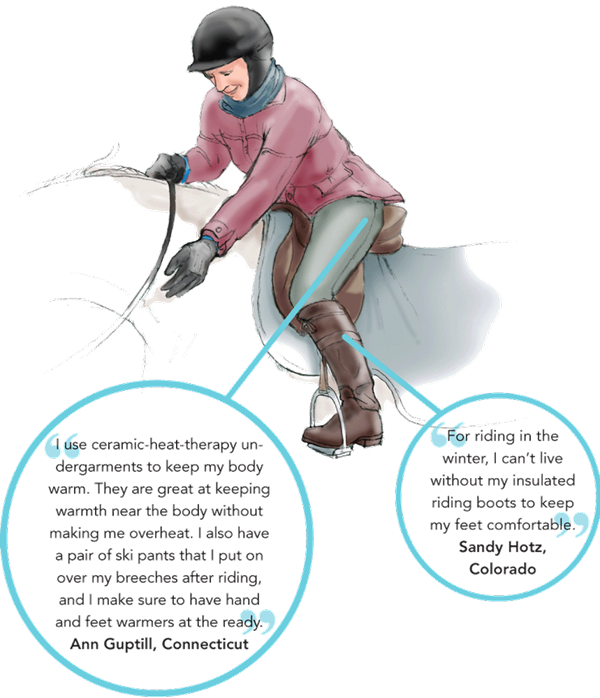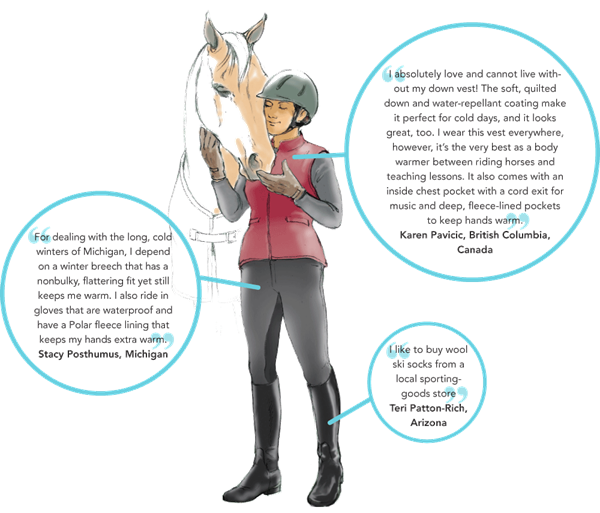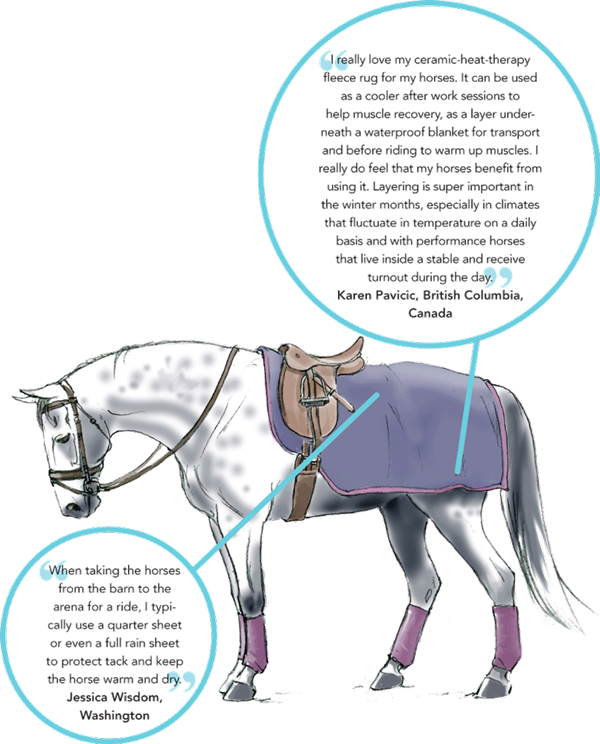As the winter months approach, it’s time to start thinking ahead and preparing for cooler temperatures. From purchasing thermal layers to insulated snow boots or extra blankets for your herd, there are many steps to prepare for winter, regardless of where in the country you and your horse are located.

For many of us, navigating the marketplace for items that provide protection from the elements for horse and human can be overwhelming. To help you find products that fit your needs this winter, we’ve compiled a guide of winter wardrobe essentials for horse and rider that we think might belong in your tack room or closet. We’ve enlisted the help of equestrian-gear expert Jennifer Hetzler, of Equus Now! Tack Shop based near Columbus, Ohio, to offer advice on what to look for in each of these cold-weather items. Additionally, we’ve consulted with several established dressage trainers across the country who face seasonal weather challenges and have discovered ways to combat cold temperatures and inclement weather. Even though riding in the winter can certainly be challenging, with the right apparel for you and your horse, you may discover that winter can be more productive than ever before.
For the Horse
Cooler
Purpose: Can be placed over the horse before and after exercise to keep him warm and dry, to wick moisture and/or prevent him from cooling off too quickly, which can result in shivering, tense muscles or muscle spasms.
Remember: Although coolers come in many forms, dress coolers that fit closely to the body of the horse are more popular than square coolers that can cover the horse past his neck. “Some riders, however, do prefer square coolers because they can be helpful for larger horses that tend to not dry out as well on their necks,” Hetzler says. “These often have ties in front instead of buckles and the open front can allow air to circulate better. You can also fold them back more gradually than a dress cooler as the horse dries and cools. This can be particularly helpful for horses with arthritis in their necks. However, due to their more cumbersome size and shape, many people opt for the dress cooler.”

Quarter Sheet
Purpose: Quarter sheets serve a similar purpose as coolers, but are worn while the horse is in work and cover the hindquarters. Quarter sheets are available in various cuts and styles. Some versions are secured underneath the saddle while others are designed to fit over the saddle and can be easily removed without the need to dismount or shift the saddle.
Remember: “Polar fleece and Polartec are preferred materials because they are lightweight and moisture-wicking,” Hetzler says. Polartec tends to be preferred over Polar fleece, as it is smoother, doesn’t pill as much as Polar fleece and has more breathability. “Wool is moisture-wicking, too, but often needs to be dry-cleaned and is heavy. Merino wool is another option, as it is lighter than regular wool, but still needs to be dry-cleaned,” she says.
Irish Knit
Purpose: Irish knits, also known as string coolers, can be used alone or underneath a heavier fleece or wool cooler to increase moisture-wicking action and help to evenly cool out a horse. Some versions can also be used as additional blanket liners. An Irish knit placed underneath a cooler sucks moisture off the horse. Warm air goes between the layers to help cool the horse off and get him to dry faster.
Remember: “When selecting an Irish knit sheet, you really want to get one that is well stitched because the loose weave of the cords needs to be held together,” Hetzler says. A poorly stitched sheet is more likely to lose its shape quickly and might eventually fall apart. She also says to check the way that the fabric is woven because these kinds of sheets can snag very easily. “I prefer Irish knits without surcingles because they are easier to take off quickly. Also, if it is being used as an undersheet for wicking purposes, it is safer without surcingles.” And, believe it or not, the color of the knit can also affect its absorbency. According to Hetzler, the most common color for an Irish knit is usually natural because it tends to be more absorbent. With a cotton fabric, once it has been dyed a darker color, the knit becomes less absorbent.
Therapeutic Blanket
Purpose: Therapeutic blankets are available in many styles for various uses. The most common therapeutic blankets on the market are designed to promote overall health and alleviate various aches and pains. They commonly incorporate heat-reflecting infrared material to increase blood circulation, soothe muscles and/or warm the horse. Other models can incorporate the use of ionic therapy, liquid titanium or magnets. While the blankets can be used in a variety of climates, many riders and trainers choose to use them especially in colder weather as quarter sheets, coolers and blanket liners.
Remember: Many professionals consider therapeutic blankets to be staples in their barns, and they come in quarter sheets, mesh sheets, fleece sheets and turnout blankets. “There’s a definite place in every barn for a therapeutic blanket,” Hetzler says. “I’ve seen a lot of horses really benefit from their use.”
For the Rider
A turtle-neck or mock turtle-neck shirt made out of a moisture-wicking technical fabric typically makes for a suitable base layer. Hetzler says that shirts worn for sun protection or those made from Ice-fil or a similar moisture-wicking material are often good options. You also might consider investing in a Polartec sweater or pullover as an additional layer.

A vest can make a good addition to a winter wardrobe, acting as an another layer or can be worn in place of a jacket in more moderate weather. Hetzler recommends a vest with Polar fleece or Polartec lining but says that down vests are good options, too. If you prefer a down vest, look for one that is less bulky to help you move better in the saddle. Vests made with Thinsulate can also be good because they help you retain heat without adding bulk.
Look for a jacket that is vented in the back and gathers in the middle. This is more flattering and also insulates heat. A jacket that is windproof and waterproof is ideal for snow.
Compression socks are great for winter riding. Look for socks that provide support in the foot and ankle area, stay up and provide compression. Some people prefer to ride in thin socks with tall boots, but thicker ones tend to provide more heat.
There are several options nowadays in terms of winter riding footwear. “Make keeping your feet warm a priority,” Hetzler says. There’s been a movement away from bulkier boots and lots of companies are starting to make boots that follow this trend. If you prefer to ride in half chaps, you can also look for a pair of insulated paddockboots and half chaps that provide a similar amount of warmth.
Hetzler recommends a nonbulky fleece-lined glove that has additional grip for riding. However, for barn work, she says that bulkier gloves are sometimes preferred.
There are a variety of options on the market for winter breeches. “If you’re riding in a full seat or knee patch, there are fleece-lined breeches that are nice enough to show in,” Hetzler says. For maximum warmth, look for a wind-proof fabric. If you want a pair of waterproof breeches, look for something that has a taped seam on the inside to keep them waterproof. Breeches with high-quality seams will also be more comfortable and won’t rub. Fleece-lined tights can be great if you mainly plan to ride at home, but make sure to check if they are windproof. Consider investing in a pair of long underwear, which can add an additional layer of warmth without the bulk.
“Neck warmers can be great to do exactly what their name suggests,” Hetzler says. There are also some Polar fleece head covers on the market that fit under your helmet and cover your head and ears.

Tips from Trainers
Jessica Wisdom, Washington
• For staying warm and dry in the rain, I wear an all-season, full-seat breech. These breeches are made of a microfiber fabric that both wicks away moisture and keeps me insulated.
• I also wear thermal layers under my riding jacket in order to maintain body heat in damp conditions.
• To keep my feet warm and dry in the mud, I recommend a 100-percent waterproof boot, which is perfect for muddy conditions in Washington. My favorite boots have a comfortable fit, good traction on ice and are lined with heat-insulating faux fur.
• For my horses, the biggest challenge is keeping them dry. For the stallions who like to destroy their blankets, I use rugs that are heavy-duty, wear well and keep the horses warm in heavy downpours.
• In the colder winter months, I use ceramic-therapy products to get the horses limbered up before exercise, especially after being outside in the damp weather.
Teri Patton-Rich, Arizona
• In the Arizona mountains, the temperature fluctuates throughout the day. Therefore, I make sure to layer my riding clothes to deal with changing temperatures. I often wear moisture-wicking, heat-insulating layers under my riding clothes, as they are warm, light and fit well under my breeches and jackets.
• For my horses, I layer their blankets and often use a blanket liner under heavy blankets. This liner adds an extra layer of insulation and warmth, especially for cold nights.
• I recommend purchasing blankets with shoulder gussets in order to prevent shoulder rubs from occurring.
Sandy Hotz, Colorado
• When teaching in the winter, I like to wear a full-length down coat with a hood. I also wear insulated snow boots purchased from an outdoor- supply company. They are similar to moon boots from the 70s and are good for teaching and barn work.
• If I keep my head and feet warm, my entire body stays much warmer when working and riding in the cold temperatures.
Ann Guptill, Connecticut
• A handy tip for hand warmers: If you get the 12-hour hand warmers but use them less than 12 hours, you can save them for the next day. I learned from a client to put them in a Ziploc bag overnight, and you will still have a few hours of heat in them the next day. This will save a few dollars a week if you are buying them at $1 to $2 a pack. If you live in the Northeast, it is best to buy a case of hand warmers before the cold weather starts. This year it became a little difficult to find them locally by mid-February.
• I use blanket hoods to keep the horses warmer on those super frigid days. Our massage therapist recommended them for some of the horses that brace against the cold. It is an easy layer to add or take off when the temperatures fluctuate. We have some horses that have light, waterproof ones added to their turnout gear to keep them dry during snowstorms.
Karen Pavicic, British Columbia, Canada
• I like an all-weather jacket, which is especially good for those who ride outdoors in rainy or snowy weather. Not only is it water resistant, but it has a unique design of a back skirt zippered gusset that fits over the top of your saddle, keeping it dry, too. This kind of jacket is very functional and also looks good.
Helpful Tips for Sheeting and Blanketing
There’s a lot to be said on the topic of blanketing and much of it is dependent on specific horses in specific climates. As a general rule, Hetzler recommends that it is ideal to own a turnout sheet, a medium-weight blanket and a heavy-weight blanket.
Rain sheets come in a variety of versions that can either be used for turnout, riding or standing ringside. They can be used simply to protect tack in inclement weather and keep your horse dry or can serve as lightweight and often breathable waterproof protection for horses turned out. For horses in harsher climates, rain sheets can be layered with heavier blankets to provide an additional level of protection from the elements.
If you’re on the hunt for a rain sheet, look first and foremost for a sheet that is waterproof and durable. “The more dense the fabric is, the more durable the sheet will be,” Hetzler advises. For example, a 600-denier fabric tends to be less dense, a 1200-denier fabric is moderately dense, and 1600 denier is highly dense. Sheets made out of ballistic nylon can be ideal because they are more breathable, waterproof and durable. Hetzler adds to also be sure to look for fabric that is rip-stop, which is easier to patch up. Sheets can make great layering tools. Layering creates a section where there is air between the blanket and the liner, which is what helps keep the horse warmer.
If you live in a more temperate climate or are interested in more budget-friendly alternatives, consider a blanket-liner. It can be a helpful layering tool that provides more warmth than a sheet but isn’t as heavy as a blanket.
As far as blankets go, high-neck versions are useful for layering. When a horse reaches down to graze, the higher-cut neck opening prevents water and snow from getting in, preventing sheets or other layers from getting wet.
Neck covers for blankets can be helpful additions for those who live in very cold climates. There are various versions of blankets that either come with a neck cover permanently attached, while in other versions, it can be removed. Hetzler says that many people prefer versions with detachable necks because they tend to be more versatile.











